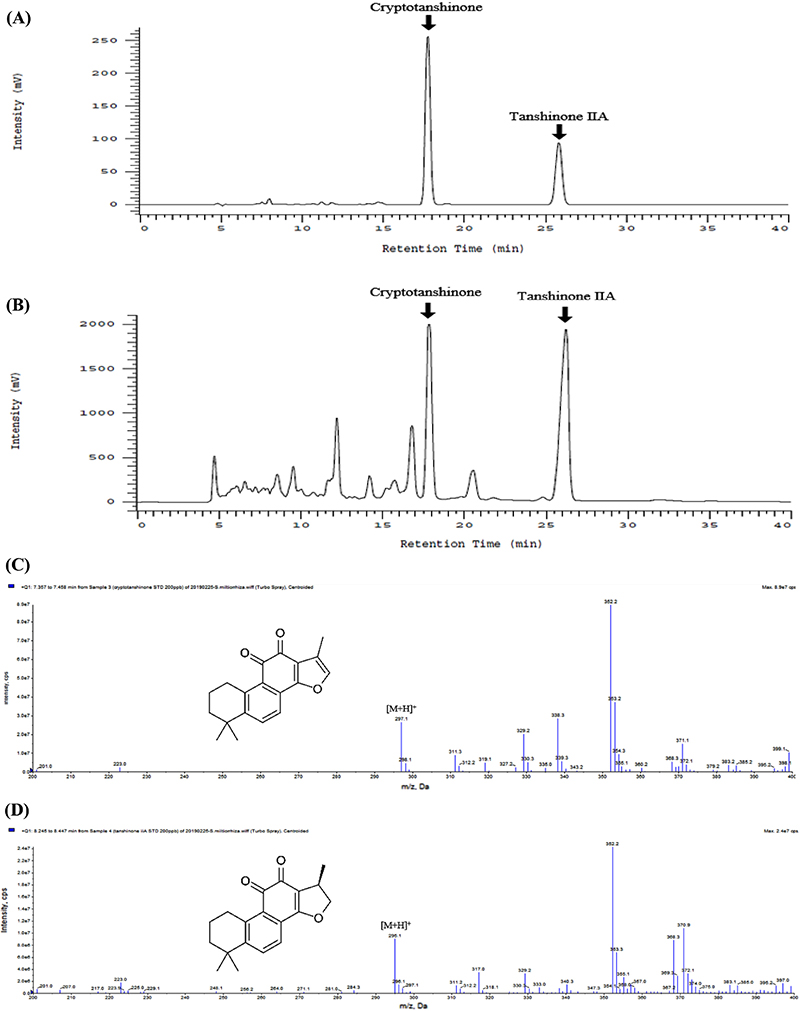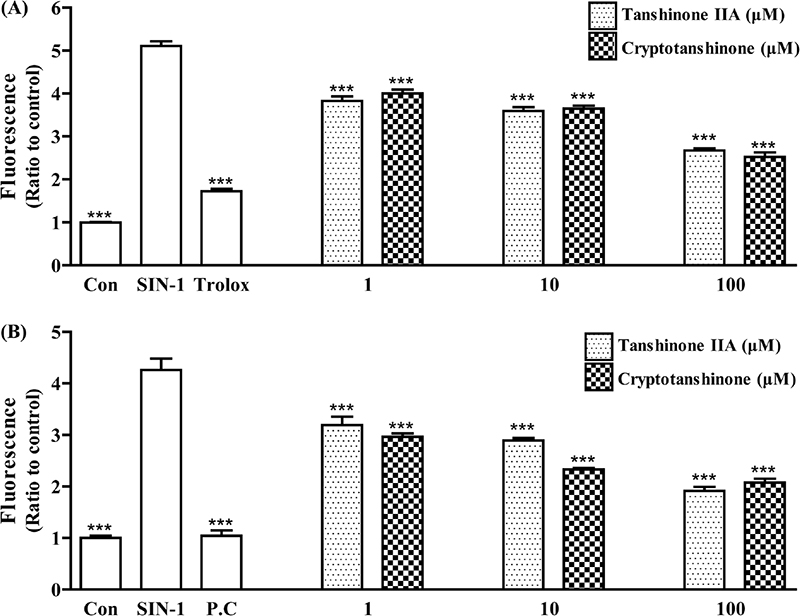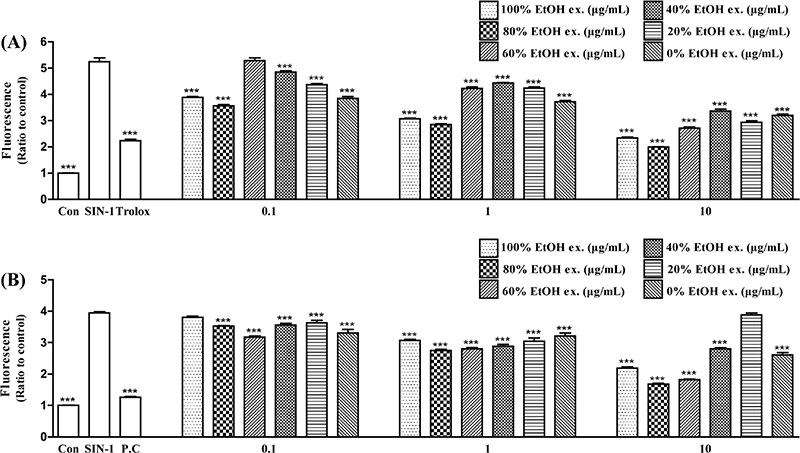
단삼 에탄올 추출물의 Tanshinone IIA와 Cryptotanshinone의 최적 추출 조건 및 항산화 효과
Correspondence to: *(E-mail): fiona30@ks.ac.kr (Tel) : +82-51-663-4883
Abstract
Salvia miltiorrhiza (S. miltiorrhiza) root contains several compounds that have a variety of physiological effects such as anti-oxidant, anti-cancer, anti-atherosclerotic, anti-inflammatory and anti-bacterial activities. S. miltiorrhiza contains diterpenoid compounds such as tanshinone Ⅰ, IIA and cryptotanshinone and phenolic compounds such as salvianolic acids A, B and C. The contents of major compounds, tanshinone IIA and cryptotanshinone, from S. miltiorrhiza were quantitatively analyzed by using high performance liquid chromatography (HPLC) to find the optimal extraction condition after the simultaneous analysis method was validated. The ROS and ONOO- scavenging assays were performed to evaluate the anti-oxidant effect of ethanol extracts from S. miltiorrhiza prepared by different extraction methods and solvents as well as tanshinone IIA and cryptotanshinone. The contents of tanshinone IIA and cryptotanshinone in extracts of S. miltiorrhiza by extraction method were the highest in immersion method with 12.255% and 7.626%. And the contents in ethanol extracts by extraction solvent were the highest in 100% ethanol with 12.407% and 8.216%. The optimized extraction condition of S. miltiorrhiza with the highest concentration of tanshinone IIA and cryptotanshinone was the immersion extraction method with 100% ethanol. The results showed that S. miltiorrhiza extracts by different extraction methods and solvents as well as tanshinone IIA and cryptotanshinone significantly have the anti-oxidant effects in a dose-dependent manner, indicating that tanshinone IIA and cryptotanshinone are effective major compounds for the anti-oxidation in S. miltiorrhiza. These results can be used as basic data for the standardization of products from S. miltiorrhiza and tanshinone IIA and cryptotanshinone can be expected to be a candidate for anti-oxidant health functional foods and herbal medicines.
Keywords:
Salvia miltiorrhiza, Tanshinone IIA, Cryptotanshinone, Optimized extraction condition, Anti-oxidant effect단삼(Salvia miltiorrhiza Bunge)은 꿀풀과(Labiatae)에 속하는 다년생 식물로, 중국에서는 전통적으로 혈액순환을 촉진시키고 정체를 풀며 정신을 안정시키고 혈액의 열을 제거하며 부종을 해소하는데 사용되어 왔다.1) 단삼의 약리작용으로는 항암, 항동맥경화, 항염 및 항균 작용 등이 알려져 있다.2-5) 단삼의 뿌리에는 tanshinone Ⅰ, IIA, ⅡB, V, VI, cryptotanshinone, isotanshinone Ⅰ, Ⅱ, ⅡB 등과 같은 친유성 성분과 salvianic acid A, B, C, salvianolic acid A, B, C, D, E, G 등과 같은 친수성 성분들이 함유되어 있고, 그 중 tanshinone IIA 및 cryptotanshinone은 주요 생리활성 성분으로 알려져 있다.6) Tanshinone IIA는 항염증, 항동맥경화증, 항균, 항종양, 지방형성 억제 등의 효과를 보이고7,8) cryptotanshinone은 항암, 항염증, 면역조절, 심장 보호, 신경 보호, 항섬유화, 항대사 장애 등의 효과를 보인다.9,10) 활성산소종(reactive oxygen species, ROS)은 산화환원 신호 전달 및 성장 조절에 있어서 다양한 생리적 역할을 수행하지만, 산화 스트레스의 부정적 효과를 일으키는 주범으로 대부분의 생체 분자를 손상시키고 지질 과산화를 유도하며 DNA 가닥을 끊는 것으로 알려져 있다.11) 활성질소종(reactive nitrogen species, RNS)인 과산화 질산염(ONOO-)은 일산화질소(•NO)와 초과산화물 라디칼(O2•−)의 확산 제어반응의 생성물로, 세포 사멸을 강력하게 유도하는 산화물질로 알려져 있다.12)
본 연구에서는 단삼의 주요성분이자 유효성분인 tanshinone IIA와 cryptotanshinone의 함량이 가장 높은 단삼의 최적 추출 조건을 찾기 위하여, 고성능 액체 크로마토그래피(high performance liquid chromatography; HPLC)를 이용하여 tanshinone IIA와 cryptotanshinone의 동시분석을 진행하였다. 단삼의 조건별 추출물들을 함량 분석하여 tanshinone IIA와 cryptotanshinone의 함량이 가장 높은 최적 추출 방법과 추출 용매를 결정하고자 하였다. 또한, 단삼의 조건별 추출물들과 유효성분인 tanshinone IIA 및 cryptotanshinone의 ROS 및 ONOO- 소거활성을 측정하여 항산화 활성을 확인하고자 하였다.
재료 및 방법
생약 재료 – 본 실험에서 사용된 단삼은 2023년에 채집하여 건조한 것을 한약재 시장 사이트에서 구입하였고, 표본(SM-2023-1)은 경성대학교 약학대학 내 표본실에 보관하였다.
시약 및 기기 – 주요 성분인 tanshinone IIA와 cryptotanshinone은 Chengdu Biopurify Phytochemicals Ltd. (Chengdu, Sichuan, PRC) 제품을 구입하여 사용하였다. HPLC 분석에 사용된 용매는 HPLC급 J. T. Baker (Philipsburg, NJ, USA) 제품을 사용하였고, 그 외 분석 및 시료 추출을 위한 시약과 용매는 1급 시약과 용매를 구입하여 사용하였다. ROS 소거활성 및 ONOO- 소거활성에 사용된 2′,7′-dichlorodihydrofluorescein diacetate (H2DCFDA)는 Invitrogen (Camarillo, CA, USA)에서 구입하여 사용하였고, esterase, trolox, 3-morpholinosydnonimine hydrochloride (SIN-1), diethylenetriaminepentaacetic acid (DTPA), dihydrorhodamine 123 (DHR 123)과 penicillamine은 Sigma-Aldrich (St. Louis, MO, USA) 제품을 사용하였다. HPLC는 Hitachi Co. (Tokyo, Japan)의 LaChrom Elite® HPLC 시스템을 이용하였고, Agilent Technologies (Santa Clara, CA, USA)의 Zorbax Eclipse Plus C18 column을 장착하여 사용하였다. 질량분석기는 AB Sciex Co. (Framingham, MA, USA)의 Triple QuadTM 4500을 사용하였으며, AB Sciex Co.의 Analyst® 프로그램을 이용하여 해석하였다. 항산화 활성 측정에 사용한 spectrophotometer는 Thermo Fisher Scientific (Waltham, MA, USA)의 VarioskanTM LUX spectrophotometer를 사용하였다.
추출물 제조 – 단삼 추출물을 제조하기 위하여 건조된 단삼 뿌리를 5 mm × 5 mm 크기로 분쇄하여 사용하였다. Tanshinone IIA와 cryptotanshinone의 함량이 높은 추출 조건을 찾기 위해 추출 방법별, 용매 조성별 단삼 추출물을 제조하였다. 추출 방법별 단삼 추출물은 단삼 50 g에 100% 에탄올 100 mL를 추가한 후 환류, 초음파 및 침지 방법으로 각각 제조하였다. 환류 추출은 3시간 동안 100℃에서 2번, 초음파 추출은 3시간 동안 30℃에서 2번, 침지 추출은 3일 동안 실온에서 1번 추출하였다. 용매 조성별 단삼 추출물은 단삼 50 g에 100, 80, 60, 40, 20 및 0% 에탄올 100 mL를 사용하여 상온에서 침지 추출을 진행하였다. 추출 후 여과한 후 감압 농축하고 동결 건조하여 각 추출물들을 얻었다.
HPLC및MS분석 – 단삼의 tanshinone IIA와 cryptotanshinone 동시분석을 위한 HPLC 분석 조건은 Table Ⅰ과 같이 설정하였고 분석 조건에 따라 함량 분석을 사용하여 진행하였다. Tanshinone IIA와 cryptotanshinone 각 1 mg을 메탄올 1 mL에 용해하여 stock solution으로 하였다. 각 stock solution을 희석하여 5, 10, 20, 50, 100 및 200 mg/L 농도의 표준용액을 제조하였다. 분석에 사용한 추출 조건에 따른 단삼 추출물들은 각 1 mg을 메탄올 1 mL에 용해하고 30분간 sonication을 진행하고 0.22 μm syringe filter로 여과하여 검액으로 사용하였다. 함량 분석 대상이 된 peak의 성분을 확인하기 위해 질량분석기를 사용하여 분자량을 측정하였다. 질량분석기의 조건은 Table Ⅱ와 같이 설정하여 진행하였다.
분석법 검증 – 분석법 검증을 위해 특이성(specificity), 직선성(linearity)과 검출 한계(limit of detection, LOD) 및 정량 한계(limit of quantitation, LOQ)를 측정하고 정확성(accuracy)과 정밀성(precision)을 평가하였다. Tanshinone IIA와 cryptotanshinone이 단삼 추출물 내 다른 물질의 간섭 없이 분리되는지 확인하기 위하여 표준용액과 단삼 추출물의 chromatogram을 비교하여 peak의 retention time을 확인하였다. 직선성과 검출 한계 및 정량 한계를 측정하기 위하여 5, 10, 20, 50 및 100 mg/L 농도로 희석해 둔 tanshinone IIA와 cryptotanshinone 표준용액들을 HPLC로 분석하여 검량선을 작성하였다. 검량선은 peak의 면적과 시료의 농도를 변수로 사용하였고, 검량선으로 얻은 상관계수(R2) 값으로 직선성을 확인하였다. 검출 한계는 3.3 × σ/S, 정량 한계는 10 × σ/S(σ: 잔차의 표준편차, S: 검량선의 기울기)로 계산하였다. Tanshinone IIA와 cryptotanshinone 표준용액들 모두 5, 100 및 200 mg/L 농도로 3일간 반복성 시험과 일 내 3회 반복 반복성 시험을 하여 정확성과 정밀성을 측정하였다. 정확성은 표준값과 측정값 사이의 근접성을 계산하여 확인하였으며, 정밀성은 반복 실험하였을 때 측정값들 사이의 근접성을 상대표준편차(RSD, %)로 계산하여 확인하였다.
항산화 활성 측정 – 단삼 추출물과 tanshinone IIA, cryptotanshinone의 항산화 활성을 측정하기 위하여 ROS 및 ONOO-소거활성을 진행하였다. 단삼 추출물은 메탄올에 녹여 최종 농도가 0.1, 1 및 10 μg/mL이 되도록 제조하여 시료로 사용하였고, tanshinone IIA와 cryptotanshinone은 최종 농도가 1, 10 및 100 μM이 되도록 제조하여 시료로 사용하였다.
ROS 소거활성은 96-well black plate에서 진행하였으며, 양성 대조군으로 100 μM trolox를 사용하였다. 12.5 mM H2DCFDA와 600 unit esterase는 같은 비율로 혼합하고 차광상태로 상온에서 20분 동안 반응시켰다. 농도별 시료를 각각 well에 투여하고 10 μM SIN-1을 각 well에 처리하였다. H2DCFDA 혼합물을 PBS에 1/50로 희석하여 각 well에 처리한 뒤 10분 동안 반응시켰다. 반응시킨 혼합물은 spectrophotometer를 사용하여 excitation 485 nm와 emission 530 nm에서 형광 측정하여 결과값을 비교하였다.
ONOO- 소거활성은 96-well black plate에서 진행하였으며, 양성 대조군으로 100 μM penicillamine을 사용하였다. 농도별 시료를 각각 well에 투여하고 10 μM SIN-1을 각 well에 처리하였다. Rhodamine buffer에 녹인 10 μM DTPA를 각 well에 처리하고 5 mM DHR123을 PBS에 1/100로 희석하여 각 well에 처리하고 10분 동안 반응시켰다. 반응시킨 혼합물은 spectrophotometer를 사용하여 excitation 485 nm와 emission 530 nm에서 형광 측정을 하여 결과값을 비교하였다.
통계처리 – 모든 실험은 5회 이상 반복으로 실시하였고, 그 결과를 평균 ± 평균의 표준오차(SEM)로 표시하였다. 통계 분석은 GraphPad Prism (version 5.0; GraphPad Software, Inc., USA)을 사용하였고 각 실험군간의 비교는 ANOVA (one-way analysis of variance)로 처리하였고, Dunnett’s multiple comparisons test를 사용하여 검정을 실시하였다. P값이 0.05 미만인 경우 통계적으로 유의성이 있는 것으로 판정하였다.
결과 및 고찰
분석법 검증 –Tanshinone IIA와 cryptotanshinone의 동시분석법을 검증을 위하여 특이성, 직선성, 검출한계, 정량한계, 정확성 및 정밀성을 확인하였다. Tanshinone IIA와 cryptotanshinone을 혼합한 표준 용액과 단삼 추출물의 peak를 확인하였을 때, 다른 물질의 간섭없이 분리되었으며 혼합한 표준용액과 단삼추출물 내 tanshinone IIA와 cryptotanshinone의 retention time이 일치하는 것을 확인하였다(Fig. 1A, 1B). 직선성을 확인하기 위하여 tanshinone IIA와 cryptotanshinone의 표준용액을 5, 10, 20, 50 및 100 mg/L의 범위로 HPLC 분석을 하여 검량선을 작성하였을 때, tanshinone IIA의 검량선 상관계수(R2)는 0.999, cryptotanshinone은 1.0으로 높은 직선성을 보였다. Tanshinone IIA의 검출 한계는 0.399 mg/L, 정량 한계는 1.316 mg/L로 확인되었고, cryptotanshinone의 검출 한계는 0.244 mg/L, 정량 한계는 0.804 mg/L로 확인되었다(Table Ⅲ). 정확성과 정밀성을 측정하였을 때, tanshinone IIA의 정확성은 95.31~101.82%, 정밀성은 0.93~1.91%의 범위였고, cryptotanshinone의 정확성은 95.27~100.42%, 정밀성은 0.93~1.99%의 범위였다(Table Ⅳ). 이러한 연구결과는 본 연구에서 사용된 분석법이 정량분석이 가능하고 재현성을 가지고 있으며, 높은 정확성과 정밀성을 가지는 동시분석법임을 나타낸다. 기존에 사용된 분석법13) 과 비교하였을 때, 본 연구에 사용된 분석법은 tanshinone IIA와 cryptotanshinone의 peak를 다른 물질의 간섭 없이 더 명확하게 분리하여 특이성을 개선하였다.

HPLC chromatograms of tanshinone IIA and cryptotanshinone standards (A) and ethanol extract from S. miltiorrhiza (B). MS spectra of tanshinone IIA (C) and cryptotanshinone (D) in ethanol extract from S. miltiorrhiza.

Calibration curves, correlation coefficients, limits of detection (LOD) and limits of quantitation (LOQ) of tanshinone IIA and cryptotanshinone
함량 분석 –주요 성분인 tanshinone IIA와 cryptotanshinone의 함량 분석을 위해 HPLC를 이용하여 동시분석 조건을 확립하였다. Table Ⅰ의 분석조건을 적용하여 분석하였을 때, 검체의 peak가 이상적으로 분리된 것을 확인하였다. MS 분석 결과 tanshinone IIA와 cryptotanshinone은 m/z 295.1 및 m/z 297.1에서 [M+H]+ 형태의 분자 이온 피크를 확인하였다(Fig. 1).
본 연구에서 확립한 분석법을 이용하여 단삼의 조건별 추출물들에 대한 tanshinone IIA와 cryptotanshinone의 함량을 분석하였다. 추출 방법별 단삼 추출물에서는 침지 추출법에서 tanshinone IIA가 12.255%, cryptotanshinone이 7.626%로 가장 높은 함량을 나타내었고(Table Ⅴ), tanshinone IIA와 cryptotanshinone이 열에 매우 불안정한 물질임을 확인할 수 있었다. 이는 단삼의 유효성분이 열에 불안정하다는 다른 연구팀의 결과와도 일치하였다.14) 용매 조성별 단삼 추출물에서는 100% 에탄올에서 tanshinone IIA가 12.407%, cryptotanshinone이 8.216%로 가장 높은 함량을 나타내었다(Table Ⅵ). 이와 같은 결과는 tanshinone IIA 및 cryptotanshinone과 같은 diterpenoid 성분들이 지용성이 강한 물질이기 때문인 것으로 생각되어진다.6) 이들 결과에 의하면, tanshinone IIA와 cryptotanshinone의 함량이 가장 높은 단삼의 최적 추출 조건은 상온에서 100% 에탄올로 침지 추출하는 것임을 확인할 수 있다.

Contents of tanshinone IIA and cryptotanshinone in ethanol extracts from S. miltiorrhiza by extraction method

Contents of tanshinone IIA and cryptotanshinone in ethanol extracts from S. miltiorrhiza by extraction solvent
항산화 활성 측정 – 단삼의 주요 성분인 tanshinone IIA 및 cryptotanshinone과 단삼의 조건별 추출물의 항산화 활성을 알아보기 위하여 ROS 및 ONOO- 소거활성 실험을 진행하였다. Tanshinone IIA와 cryptotanshinone의 ROS 및 ONOO- 소거활성은 농도 의존적으로 높아졌다. ROS 소거활성에서 tanshinone IIA와 cryptotanshinone은 100 μM 농도에서 47.7 및 50.6%의 소거활성을 보였고, ONOO- 소거활성에서는 100 μM 농도에서 55.1 및 51.2%의 소거활성을 보였다(Fig. 2). 단삼의 추출 방법별 추출물의 소거활성 분석을 진행하였다. 추출 방법별 추출물의 ROS 및 ONOO- 소거활성은 농도 의존적으로 높아졌으며, ROS 소거활성은 침지 추출물 10 μg/ml 농도에서 55.1%로 가장 높은 소거활성을 보였고, ONOO- 소거활성에서는 침지 추출물 10 μg/ml 농도에서 47.1%로 가장 높은 소거활성을 보였다(Fig. 3). 단삼의 용매 조성별 추출물의 ROS 및 ONOO- 소거활성 분석을 진행하였다. 용매 조성별 추출물의 ROS 및 ONOO- 소거활성은 농도 의존적으로 높아졌으며, ROS 소거활성에서는 80% 에탄올 추출물 10 μg/ml 농도에서 62.0%로 가장 높은 소거활성을 보였고, ONOO- 소거활성에서는 80% 에탄올 추출물 10 μg/ml 농도에서 가장 높은 소거활성을 보였다(Fig. 4).

Anti-oxidant effect of tanshinone IIA and cryptotanshinone standards. ROS scavenging assay (A) and ONOO- scavenging assay (B). Data are presented as mean ± SEM, and statistical significance was analyzed by one-way ANOVA followed by Dunnett’s multiple comparisons test. CON, control; SIN-1, 3-morpholinosydnonimine hydrochloride; Trolox, positive control, 100 μM of trolox; P.C, positive control, 100 μM of penicillamine. ***P < 0.001 compared to SIN-1.

Anti-oxidant effect of ethanol extracts from S. miltiorrhiza by extraction method. ROS scavenging assay (A) and ONOO- scavenging assay (B). Data are presented as mean ± SEM, and statistical significance was analyzed by one-way ANOVA followed by Dunnett’s multiple comparisons test. CON, control; SIN-1, 3-morpholinosydnonimine hydrochloride; Trolox, positive control, 100 μM of trolox; P.C, positive control, 100 μM of penicillamine. ***P < 0.001 compared to SIN-1.

Anti-oxidant effect of ethanol extracts from S. miltiorrhiza by extraction solvent. ROS scavenging assay (A) and ONOO- scavenging assay (B). Data are presented as mean ± SEM, and statistical significance was analyzed by one-way ANOVA followed by Dunnett’s multiple comparisons test. CON, control; SIN-1, 3-morpholinosydnonimine hydrochloride; Trolox, positive control, 100 μM of trolox; P.C, positive control, 100 μM of penicillamine. ***P < 0.001 compared to SIN-1.
함량 분석과 소거활성 결과를 비교하였을 때, 추출 방법별 단삼 추출물 중에서 침지 추출물이 tanshinone IIA 및 cryptotanshinone의 함량이 가장 높았고 가장 높은 항산화 효과를 나타내며 함량과 항산화 효과가 일치하는 결과를 보였다. 용매 조성별 단삼 추출물에서는 tanshinone IIA 및 cryptotanshinone의 함량은 100% 에탄올 추출물에서 가장 높았으나, 항산화 효과는 80% 에탄올 추출물에서 가장 높아 함량과 항산화 효과가 일치하지 않는 결과를 보였다. 이는 80% 에탄올 추출물에 dimethyl lithospermate B나 salvianolic acid A, B 등과 같은 또 다른 항산화 활성을 가진 성분들이 존재하기 때문으로 예상되어진다.15-18) Tanshinone IIA 및 cryptotanshinone을 가장 많이 함유한 100% 에탄올 추출물이 가장 높은 항산화 효과를 보이지는 않았지만, 이들 성분들은 단삼 추출물과 유사하거나 더 높은 항산화 효과를 보여주었다. 이를 통하여 tanshinone IIA 및 cryptotanshinone은 항산화 활성을 가진 단삼의 유효 성분임을 확인할 수 있었다.
결 론
본 연구에서는 분석법 검증을 통해 단삼의 tanshinone IIA와 cryptotanshinone의 HPLC 동시분석법을 확립하고, 추출 조건에 따른 단삼 추출물에서 tanshinone IIA와 cryptotanshinone의 함량을 높일 수 있는 최적 추출 조건을 확립하고자 하였다. 또한, 단삼의 조건별 추출물들과 tanshinone IIA 및 cryptotanshinone의 항산화 활성을 확인하기 위하여 ROS 및 ONOO- 소거활성 실험을 진행하였다. 추출 방법별 단삼 추출에서는 침지 추출물에서 tanshinone IIA는 12.255%, cryptotanshinone은 7.626%로 가장 높은 함량을 보였고, 용매 조성별 단삼 추출에서는 100% 에탄올 추출물에서 tanshinone IIA는 12.407%, cryptotanshinone은 8.216%로 가장 높은 함량을 보였다. 다음과 같은 결과를 통하여 tanshinone IIA와 cryptotanshinone의 함량이 가장 높은 최적 추출 조건은 상온에서 100% 에탄올을 사용하여 침지 추출하는 것임을 확인하였다. ROS 및 ONOO- 소거활성 실험을 통하여 tanshinone IIA와 cryptotanshinone이 농도 의존적으로 소거활성을 보였으며 유효한 항산화 성분인 것을 확인하였다. 추출 방법별 단삼 추출에서는 침지 추출물의 소거활성이 가장 높았으며, 용매 조성별 단삼 추출에서는 80% 에탄올 추출물의 소거활성이 가장 높았다.
본 연구에서는 HPLC 동시분석을 이용하여 열에 불안정한 tanshinone IIA와 cryptotanshinone의 함량을 높일 수 있는 최적 추출 조건을 확립하였고, 단삼 추출물의 tanshinone IIA와 cryptotanshinone의 항산화 활성을 확인하여 유효한 항산화 활성 성분임을 확인하였다. 이 결과는 단삼을 이용한 제품의 표준화를 위한 기초 자료로 활용될 수 있으며, 항산화 활성을 가진 건강기능식품 및 천연물 의약품의 소재로 활용될 수 있을 것으로 사료된다.
References
-
Li, M., Li, Q., Zhang, C., Zhang, N., Cui, Z., Huang, L. and Xiao, P. (2013) An ethnopharmacological investigation of medicinal Salvia plants (Lamiaceae) in China. Acta Pharm. Sin. B3: 273-280.
[https://doi.org/10.1016/j.apsb.2013.06.001]

- Cheang, G. C., Lee, J. Y., Kim, D. C., Suh, S. O. and Hwang. W. I. (2000) Inhibitory effect of Salvia miltiorrhiza extract on growth of some cancer cells. J. Korean Soc. Food Sci. Nutr. 29: 726-731.
-
Wu, W. Y. and Wang, Y. P. (2012) Pharmacological actions and therapeutic applications of Salvia miltiorrhiza depside salt and its active components. Acta Pharmacol. Sin. 33: 1119-1130.
[https://doi.org/10.1038/aps.2012.126]

-
Chae, H. J., Chae, S. W., Yun, D. H., Keum, K. S., Yoo, S. K. and Kim, H. R. (2004) Prevention of bone loss in ovariectomized rats: the effect of Salvia miltiorrhiza extracts. Immunopharmacol. Immunotoxicol. 26: 135-144.
[https://doi.org/10.1081/IPH-120029951]

-
Zhang, J., Liang, R., Wang, L. and Yang, B. (2019) Effects and mechanisms of Danshen-Shanzha herb-pair for atherosclerosis treatment using network pharmacology and experimental pharmacology. J. Ethnopharmacol. 229: 104-114.
[https://doi.org/10.1016/j.jep.2018.10.004]

- Wang, B. Q. (2010) Salvia miltiorrhiza: chemical and pharmacological review of a medicinal plant. J. Med. Plant. Res. 4: 2813-2820.
-
Guo, R., Li, L., Su, J., Li, S., Duncan, S. E., Liu, Z. and Fan, G. (2020) Pharmacological activity and mechanism of tanshinone IIA in related diseases. Drug Des. Devel. Ther. 14: 4735-4748.
[https://doi.org/10.2147/DDDT.S266911]

- Jeong, S. I., Lee, J. W. and Jang, S. I. (2009) Effects of tanshinone IIA from Salvia miltiorrhiza Bunge on induction of apoptosis and inhibition of adipogenesis in 3T3-L1 cells. J. Physiol. & Pathol. Korean Med. 23: 1409-1415.
-
Li, H., Gao, C., Liu, C., Liu, L., Zhuang, J., Yang, J., Zhou, C., Feng, F., Sun, C. and Wu, J. (2021) A review of the biological activity and pharmacology of cryptotanshinone, and important active constituent in Danshen. Biomed. Pharmacother. 137: 111332.
[https://doi.org/10.1016/j.biopha.2021.111332]

-
Wu, Y. H., Wu, Y. R., Li, B. and Yan, Z. Y. (2020) Cryptotanshinone: a review of its pharmacology activities and molecular mechanisms. Fitoterapia145: 104633.
[https://doi.org/10.1016/j.fitote.2020.104633]

-
Zarkovic, N. (2020) Roles and functions of ROS and RNS in cellular physiology and pathology. Cells9: 767.
[https://doi.org/10.3390/cells9030767]

-
Szabo, C., Ischiropoulos, H. and Radi, R. (2007) Peroxynitrite: biochemistry, pathophysiology and development of therapeutics. Nat. Rev. Drug Discov. 6: 662-680.
[https://doi.org/10.1038/nrd2222]

-
Shi, Z., He, J., Yao, T., Chang, W. and Zhao, M. (2005) Simultaneous determination of cryptotanshinone, tanshinone Ⅰ and tanshinone IIA in traditional Chinese medicinal preparations containing Radix Salvia miltiorrhiza by HPLC. J. Pharm. Biomed. Anal. 37: 481-486.
[https://doi.org/10.1016/j.jpba.2004.11.015]

- Hu, G., Wang, X. and Lee, F. S. C. (2001) Thermal decomposition of tanshinone IIA during its solvent extraction from Salvia miltiorrhiza Bunge. Anal. Sci. 17: a479-a481.
-
Kang, H. S., Chung, H. Y., Jung, J. H. Kang, S. S. and Choi, J. S. (1997) Antioxidant effect of Salvia miltiorrhiza. Arch. Pharm. Res. 20: 496-500.
[https://doi.org/10.1007/BF02973947]

-
Kim, J. Y., Kim, H. S., Kang, H. S., Choi, J. S., Yokozawa, T. and Chung, H. Y. (2008) Antioxidant potential of dimethyl lithospermate isolated from Salvia miltiorrhiza (red sage) against peroxynitrite. J. Med. Food11: 21-28.
[https://doi.org/10.1089/jmf.2007.040]

- Tsai, M. K., Lin, Y. L. and Huang, Y. T. (2010) Effects of salvianolic acids on oxidative stress and hepatic fibrosis in rats. Toxicol. Appl. Pharmacol. 12: 899-915.
-
Könczöl, Á., Kéry, Á., Keserű, G. M. and Balogh, G. T. (2010) LC determination of peroxynitrite scavenging activity of phenols from Salvia spp. Chromatographia71: 51-59.
[https://doi.org/10.1365/s10337-010-1528-7]
